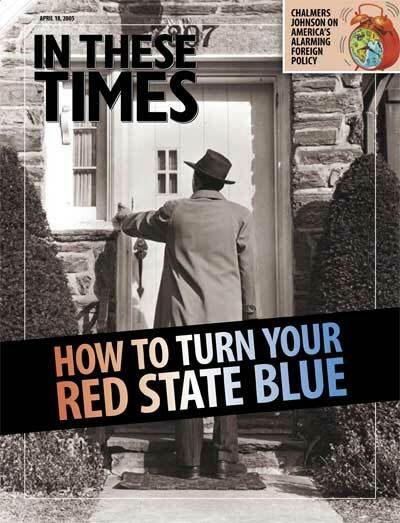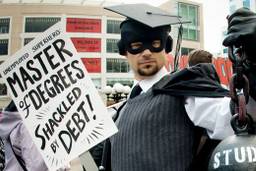Politicizing the Personal: Growing the Progressive Movement
Organizers should focus on ‘points of access’ to engage with those outside the progressive base.
Christopher Hayes

Last fall, I spent seven weeks in the suburbs of Madison, Wisconsin, canvassing undecided voters for John Kerry. Driving back one day from a long session pounding the pavement, our car passed two young Mormon missionaries on bicycles. They were dressed in their standard garb: grim but oddly stylish black suits, white shirts, skinny ties and backpacks, all of which were getting soaked in the rain as they struggled up a hill, standing on their pedals for extra leverage.
“Now that,” said a fellow organizer sitting in the backseat, “is canvassing.”
Going door to door was hard enough. My pulse would quicken at each door, and after three hours tromping through numbing subdivisions I invariably got the urge to fill in numbers on my walk sheet, grab a soda and wait for the carpool to pick me up. And all we wanted was three minutes of someone’s time to ask a few questions, give a short pitch and hand out some literature. A missionary who approaches a stranger’s door is seeking nothing less than a complete reconstitution of that person’s worldview. One imagines a lot of door slamming, unpleasant words and icy stares.
And yet the improbable fact about missionary activity is that it works, regardless of the faith’s specific dogma. Mormons are the fastest-growing church in the country. Evangelical protestant congregations make up 58 percent of all new churches in the United States. Globally, Islam continues to reach into new and unfamiliar lands, experiencing explosive growth in China. Religions that actively proselytize – Pentecostals, Mormons, Muslims – grow, almost without exception.
There’s a corollary to this in politics. Yale political scientists Donald P. Green and Alan S. Gerber have found in numerous studies of voter contact that face-to-face canvassing is far and away the most effective means of persuasion: Roughly one out of every 15 voters approached at the door will add their vote to your tally.
In a speech accepting his new position as chair of the Democratic National Committee, Howard Dean stressed the importance of reaching out to unbelievers through retail politics. “People will vote for Democratic candidates in Texas, and Utah, and West Virginia,” he said, “if we knock on their door, introduce ourselves and tell them what we believe.”
Five months after the election, progressives’ efforts have largely shifted away from people’s doorsteps, toward saving Social Security, opposing reactionary judicial appointees and reining in the administration’s foreign policy. But I can’t stop thinking about those Mormons on their bicycles. What are progressives doing to win conversions to our faith? Where are our young people on bikes approaching unfamiliar doors? How are we preaching the good news?
The true political nature of Americans
In all the ink spilled post-November about “What We Need To Do Now,” precious few answers to this question have been put forth. Commentators seem to think either (a) we don’t need to convert people because they already have fundamentally progressive values, or (b) converting voters is impossible, so the Democratic Party should just become more conservative. Both views are misleading and counterproductive; they divert attention from the crucial work of expanding the reach of progressivism.
Joe Conason, in his book Big Lies: The Right-Wing Propaganda Machine and How It Distorts the Truth (published before the election), offers a succinct articulation of the first theory: “Whether they now describe themselves as liberal or not, most Americans remain strongly progressive in their views about taxation, health care, education spending, Social Security, environmental protection and corporate regulation.”
There are heaps of polls supporting this claim, but before concluding that the Democratic Party’s recent misfortunes are the result of mass confusion or false consciousness, these polls must be considered alongside other evidence that suggests something deeper is at work.
Over the past several decades, the Democratic Party’s traditional advantage in party identification has evaporated. Equal numbers of voters now consider themselves Democrats and Republicans. In 1977, upward of 45 percent of the population identified themselves as Democrats. Even more dramatic are the percentages of “liberals” and “conservatives” in the electorate. In exit polls from 2004, 34 percent of voters identified as conservative while only 21 percent identified as liberal.
Then there’s the fact that both the government’s policies and the electorate’s voting behavior have shifted dramatically to the right in the last 30 years. Common sense would suggest that the best explanation for this is that most voters are conservative and the Republicans are the conservative party. If this is true, we cannot continue to imagine there exists a slumbering progressive majority waiting to be awakened with the right trumpet call. We cannot cling to the fiction that conservatives have somehow hypnotized the electorate, hoodwinking them into voting for Republicans and reactionaries while leaving untouched their internal worldviews, which somehow remain fundamentally progressive. It is important that we stare directly into the sun on this point. The right has fundamentally reconstituted the way Americans view government, politics, policy and the public sphere. We need to change it back.
In contrast to Conason, and others who have faith in the innate progressivism of the American voters, are Beltway strategists who take the polity’s rightward turn as a given and subscribe to thesis (b), that conversion is impossible. Democrats can revive their party, they argue, only by changing their positions so that they more closely represent the conservative electorate.
Members of the Democratic Leadership Council (DLC) and its founder Al From adhere to this line of thinking. Within the DLC are two groups: One says Democrats need to win back white working class voters by moderating on social issues (abortion, gay marriage, etc.), while another seeks to poach socially moderate, suburban, Christine Todd Whitman-like Republicans by promulgating an even more slavishly pro-business, free market platform.
Such repositioning can easily be self-defeating. In politics it’s often more important that you stand for something rather than what you stand for. Like clockwork, every two years the DLC urges the Democrats to “move to the middle” during campaigns. Then, when candidates take their advice and the inevitable failure ensues, Al From & Co. chide the party for not having gone far enough. The most common complaint I heard while canvassing in Wisconsin was that voters didn’t know what Kerry stood for. And a recent Democracy Corps poll reported that twice as many people thought that the Republican Party knows what it stands for. Diluting what little there is left of the Democratic brand seems a poor marketing idea.
In other words, when someone proves initially unreceptive to an evangelizer’s pitch, the young missionary doesn’t then say, “Well, would you be interested in converting if you didn’t have to believe in Jesus?”
Good cop, better cop
There’s a deeper philosophical question, though: What profit a party if it gain a majority and lose its soul? Even if it were true that a kind of neo-Clintonian Democratic majority is the best that can be achieved in the short term, the ultimate goal for progressives is the implementation of policies that promote social and economic justice, a more robust safety net, greater opportunity for all and the democratization of corporate power. Which is to say, electoral victories are means to ends.
Too often, we view the goals of winning elections and implementing a progressive agenda as inherently contradictory, when they can actually be parallel and mutually reinforcing. Creating more self-identified progressives accomplishes both: It creates more Democratic voters and builds a constituency for progressive policies.
Currently, a dysfunctional division of labor exists between Democratic politicians and the progressive base, in which the base spends much of its energy attempting to stop Democratic politicians from selling out core progressive principles, while it is left to the politicians to reach out to those in the mushy middle.
Ideally progressives should be giving candidates cover to implement a progressive agenda by doing the reaching out and convincing themselves. Kerry and Bush won liberals and conservatives by equal margins, respectively, but with conservatives outnumbering liberals five to three, Kerry’s nine-point margin among moderates wasn’t enough for victory. “Given the big conservative edge over liberals, that was the election,” observed E. J. Dionne in the Washington Post. “Unless liberalism can refurbish itself, it will continue to be a drag on Democratic opportunities.”
If a political party’s job is to win elections by doing what is politically expedient, the activist’s job is to make doing the right thing politically expedient. The GOP base hollers and screams about judicial nominations, while senators like Arlen Specter and Orrin Hatch present themselves as voices of moderation, but the overall outcome has been a significant and scary rightward lurch in the federal judiciary. I’ve interviewed right-wing activists who rail against the GOP for selling them out on judicial nominees, but at some level they know they’re winning, slowly but surely.
Over the years, progressives have used this bad cop-good cop dynamic to great effect: The tension between labor led by John Lewis (bad cop) and Franklin Roosevelt (good cop) produced the National Labor Relations Act. Martin Luther King and the civil rights movement (bad cop) and LBJ (good cop) brought about the Civil Rights Act and Voting Rights Act.
The lesson is that political parties are empty vessels. A party without a sufficiently militant base will end up standing for very little, and voters would rather vote for something than for nothing. At the same time, however, a party too tightly controlled by its base will likely pull the party toward electoral failure. Only by the productive interchange between activists and the party hierarchy can electoral success and long-term implementation of an ideological vision both be achieved. The challenge is to reach out without selling out. Today, the Democratic Party is failing to do the former while succeeding in the latter. It’s the worst of both worlds.
Rick Perlstein, in his marvelous Before the Storm: Barry Goldwater and the Unmaking of the American Consensus, writes of a young, ambitious Brent Bozell surveying the prospects for conservatism in 1959. As opposed to fellow Republicans, “who simply assumed a bedrock majority of Americans thought just like them,” Bozell argued there was no conservative majority in America. “A conservative electorate,” he wrote after Democratic victories in the 1958 mid-term elections, “has to be created.”
Since Bozell wrote those words, he and his allies have succeeded in building that electorate largely by making more people into conservatives. The operative question for building a long-term progressive majority is not how we stitch together 51 percent of the voters into the Democratic quilt, nor how we wake people up to their own elusive progressivism. It is how we make more progressives.
Points of access
Getting my hair cut the other day, my hairdresser, a gay man in his 40s who just went back to school to become a social worker, told me about his family’s politics. “I can’t even discuss politics with my siblings,” he said. “My sister is a born-again Christian and my brother is the second best Army recruiter in the nation.” He paused for effect. “And they say my lifestyle recruits.”
That accusation is one of the loopier bits of right-wing slander, but it’s part of a larger narrative that claims the entire left is scheming non-stop to seduce and indoctrinate the unsuspecting. This is a comical bit of projection because it is the right that has so effectively created institutions to preach conservatism and win converts.
Examples of right-wing outreach abound, not the least of which are the numerous evangelical churches that became functionally indistinguishable from the Republican Party during the last election. Right-wing talk and Christian radio dominate the airwaves. The “pro-life” movement has created organizations like Feminists for Life and blackgenocide.org that seek to draw in those who don’t initially self-identify as conservatives. Under Karl Rove’s guidance, the GOP has aggressively courted Latinos through business and professional associations and African Americans through black churches. Conservative think tanks have funded right-wing undergraduate publications and groups that bring conservative stars to campus. The Federalist Society – a club of right-wing lawyers, many of whom played key roles in the Clinton impeachment and now populate the federal judiciary – distributes literature and hosts events attended by almost every first-year law student in the country, many of whom don’t realize the group, with its innocuous-sounding name, is essentially a training program for conservative movement lawyers.
As the right has actively pursued a program of evangelization, it has simultaneously sought to infiltrate, discredit or destroy any institution that exposes people to progressive thought.
Consider a baby born in 2005 to a conservative family anywhere in America – that is anywhere outside of a major city where the very particles in the air are liberal. How might this child become a progressive? Her first possible exposure to a progressive worldview would be through children’s media: books, videos and television shows. Conservatives patrol this border vigorously. Every several months or so, it seems James Dobson or Jerry Falwell is in high dudgeon railing against the perversions of some innocuous children’s television character, from Bert and Ernie to SpongeBob SquarePants. Most recently, conservatives targeted Buster the cartoon rabbit, whose visit in one episode of his PBS show to a lesbian couple in Vermont prompted an angry rebuke from Secretary of Education Margaret Spellings.
Next, the child will likely attend public school, an institution conservatives have sought to control by taking over local school boards in order to introduce creationist textbooks, establish abstinence-only sex education and excise any lesson plans tolerant of homosexuality. And while activists seek to influence local curricula, right-wing think tanks advocate fully dismantling public education through vouchers and other ruses.
If our hypothetical student goes to college she will finally, for the first time, come face to face with a progressive worldview. Higher education stands as the only institution in American life today with a significant progressive presence. In classes, in clubs and in dorms, students are exposed to progressives and their views. Not surprisingly, Kerry won college-educated women by nine points, and all voters with post-graduate degrees by 11 points. And while he lost college-educated men, the trend lines are promising. He managed to do four points better than Gore.
Since college enrollment continues to climb, and the economy increasingly puts a premium on post-graduate degrees, this bodes well for Democrats. Conservatives realize this chink in their armor, which explains why their attacks on higher education are so ardent. David Horowitz’s latest anti-university gimmick is Students for Academic Freedom, a Web site where disgruntled conservative undergrads can post complaints, like this one, about unfair treatment from liberal faculty:
On the last [paper], I wrote about how family values in the books weve [sic] read aren’t good. I know the paper was pretty much great [sic] because I spell checked it and proofred [sic] it twice. I got an [sic] D- just because the professor hates families and thinks its [sic] okay to be gay.
Absurd as this is, Horowitz remains a serious threat. Currently eight different state legislatures are considering the Horowitz-authored “Academic Bill of Rights,” which, unsurprisingly, would revoke academic freedom by making the government enforce some ill-defined “diversity.” (Critics have pointed out that, as the bill currently reads, it could become mandatory for the underrepresented political views of, say, al Qaeda to be more widely taught.) There are already numerous conservative influences on contemporary campuses: business schools, well-funded publications, economics departments and major corporations that partner with universities in research. With the attacks of Horowitz and others intensifying, we must defend the independent progressive character of American undergraduate education with every arrow in our quiver.
Let’s say, though, that our hypothetical youngster doesn’t go to college, and instead enters the workforce. If her job is unionized, she will immediately be exposed to progressive ideas about fairness and workplace democracy, but the odds are overwhelmingly against her holding a union job. Over the last 30 years, unionization has fallen from more than 35 percent to less than 12 percent of the workforce due to, among other things, a sustained attack by Republicans on the right to organize. From the instant the National Labor Relations Act passed in 1935, the business class has recognized that unions are the most direct means by which working-class voters are brought into the left. Being in a union has an even more dramatic effect on voting behavior than college. Kerry won two-thirds of union members, and among working-class white voters, a group Kerry lost by 24 points, he won a majority of those in a union.
In fact, when you survey the trend lines in the Democratic coalition, you see an odd but altogether predictable trend. College-educated voters are increasingly moving to the left while working class voters are moving to the right. A host of ideas have been put forward to explain this, but the erosion of labor unions and the progressive character of the academy accounts for much of it.
Outside of school, work and friends, the only other real entry point for our hypothetical subject is the Internet and blogosphere. And while these are invaluable resources for people who have no other access to progressive ideas, they don’t ring your doorbell or leaflet your local supermarket. High-profile groups such as NARAL Pro-Choice America, the Sierra Club and People for the American Way don’t help much either. Though they fight tooth and nail for progressive causes, they are essentially self-contained, devoting little energy toward recruiting non-progressives. Organizations like MoveOn and Democracy For America have revived grassroots, meeting-based membership organizations, but they serve chiefly as a means of coordinating existing progressives rather than pulling new people into the fold. How would moderates, conservatives or those with little in the way of fixed politics ever find themselves interfacing with MoveOn other than a TV ad?
Growing the flock
Andy Stern, the controversial head of the nation’s fastest-growing union, Service Employees International Union, likes to say that he’s a “radical about growth.” He’s recently made waves in the labor movement by pushing for radical restructuring of the AFL-CIO, with an eye toward focusing the movement’s efforts on organizing new workers and bringing millions more under labor’s tent. He points out that while unions poured unprecedented resources into the 2004 presidential campaign and did an impressive job of getting their members to the polls to vote for John Kerry, there simply weren’t enough union members to swing the election.
The same could be said of progressives in general: We can mobilize all we want, but if we are mobilizing a shrinking group of people, it’s worth little.
In order to grow, progressives need to systematically expand the universe of access points to the progressive worldview and actively recruit people into the fold. There are three main ways this can be achieved: the development of a vibrant progressive mass media, a revived labor movement, and the organizing of large-scale grassroots social movements in regions and among constituencies that are currently estranged from progressivism. Many astute commentators have written extensively about the first two, so it seems wise to focus here on why the third part of this strategy is important, and what it might entail.
Once upon a time, organizing meant more than coordinating e-mail petitions or hosting house parties to raise money and awareness. It meant something much closer to what we now think of as missionary work. A union would send an organizer into, say, a small mining town in Pennsylvania. He would reach out to the miners, get to know them and their families, and tell them what a union was and how it could help them. He would try to convince them to risk their livelihoods by banding together and demanding a safer workplace and better wages. This was difficult, often bloody work. But when it worked – and often it didn’t – it effected a transformation of the miners who joined the union. They now had a new identity. Even if they had joined solely for higher wages or a mine less likely to kill them, after suffering lockouts, harassment and possibly beatings, they would have an entirely new perspective on bosses and power. They would be more progressive.
This is what social movements at their best do. They pull back the curtain on power and expose its workings. They politicize those without political engagements by transforming personal grievances in the workplace, at home and in society into political issues. Before the labor movement, a dangerous workplace, low wages and arduously long workdays were just crappy things about a person’s life. Before feminism, stifling your personal ambitions in favor of doting on your husband was just a drawback to being a woman.
And here’s one point of access that conservative policies are inadvertently expanding: the moments of personal crisis – unmanageable debt, hospitalization without health insurance, lack of mental health services, sudden unemployment – that reveal to Americans that the right’s ideology of “personal responsibility” masks the destruction of a social safety net for middle-and lower-income workers.
Movements draw people into something larger than themselves and show them who their friends and enemies are. A union organizer once told me, “I do this work for the three or four times a year when you look in a worker’s eyes and you see she realizes what she’s up against.”
Through opposition and conflict, movements introduce their participants to a broader political ethos, one that may have a host of specific ideological commitments that are initially foreign. In What’s the Matter with Kansas? Thomas Frank highlights how this works on the right. The working-class Kansans he describes who became involved with Operation Rescue because of a strongly held religious belief in the iniquity of abortion didn’t start out with a position on the inheritance tax, school vouchers or energy deregulation. But to join the “pro-life” movement is to join the conservative movement as a whole. Quickly members learn who their enemies are – liberal elites, college professors, Hollywood, feminists – and through a sort of ricochet reasoning set their politics on other issues in opposition. Unions work in a similar fashion. When you learn that the boss’s interests are, in many cases, diametrically opposed to your own, you start listening to what positions the boss takes and then take the opposite.
Taking on creditors
So what would a newly evangelical kind of progressive movement look like in 2005 and beyond?
Here’s an idea. One thing that nearly all Americans share is debt. Building a movement around credit reform – through the formation of local “debt clubs” that would be part of a national campaign, for example – would be one way for progressives to reach out to non-believers.
Almost one in seven households have declared bankruptcy. Many middle class families that took out second mortgages during the ’90s refi craze are now skating on thin ice. The average American family saw its credit card debt rise 53 percent during the ’90s. Credit card companies have dramatically raised late fees – revenue from which increased fourfold between 1996 and 2001 – while reducing minimum payments.
The result is that people stay in debt longer and pay more. Using an industry standard 2 percent minimum payment, a $5,000 balance will now take 32 years to pay off, at an interest cost of almost $8,000. In the last decade, more than 14,000 payday lending establishments have sprung up across the country wherever there are working and poor people living paycheck to paycheck (including military bases). Their short-term, high-interest loans, which are easily rolled over, can approach annual rates of 450 percent.
Young people today are beginning their adult lives already buried in debt: The average college student now graduates with $18,900 in student loans, the bulk of it non-subsidized debt at commercial interest rates. The interest costs of these loans are likely to increase as Republicans seek to cut federally subsidized Stafford loans and Pell grants.
We have a moral obligation to do something about this. Fighting against usury and the persecution of debtors has a long religious history as well as a social justice lineage. If there is one value that progressives should stand for, it is the democratization of capitalism, and few things are as inherently undemocratic as a society where large numbers of middle- and working-class people are at the mercy of a small group of unregulated creditors. Building an anti-debt movement would also be an appropriate strategy for these post-industrial times, when consumers are exploited for their purchasing power just as workers are for their cheap labor. As our economy gets riskier by the day, we need policies that mitigate that risk, not exacerbate it.
Organizing around debt makes a lot of political sense. It hits families with children especially hard (a group Kerry lost by a 19 percent margin). It unites a wide swath of the electorate – urban, rural, black, Latino, white – and has special resonance in places where Democrats fare worst. The 10 states with the highest bankruptcy rates are all red states – Utah, Tennessee, Nevada, Georgia, Indiana, Alabama, Arkansas, Ohio, Mississippi and Idaho.
A movement for credit reform also has the potential to drive a wedge between cultural and fiscal conservatives, weakening the coalition of conservative interests while building the progressive “brand” by re-associating progressives with fairness, justice and populism. There’s ample precedent. During his famous Cross of Gold speech in 1896, populist presidential candidate William Jennings Bryan, who in many ways forged the 20th century Democratic Party, asked: “Upon which side will the Democratic Party fight – upon the side of ‘the idle holders of idle capital,’ [i.e., the banks], or upon the side of ‘the struggling masses’?”
The moment is also right. The criminally venal bankruptcy bill just passed in the Senate (with the votes of 18 Democratic Senators) caught the attention of the progressive blogosphere, which helped launch an unsuccessful bid to derail it. Ultimately that effort failed because there was no national, grassroots movement made up of debtors. Creating one should be a top progressive priority.
Americans Coming Together (ACT), a massive voter organization group, could, in a future incarnation, select 100 red counties in red states with high bankruptcy rates and pay for two organizers and an office in each. The organizers would use the extensive e-mail lists of groups like MoveOn and Democracy for America to recruit volunteers from among local progressives, and reach out to people in the area who are in serious debt through canvassing, fliers and other means.
They could form these local debt clubs that would offer an opportunity to share experiences and get practical advice about consolidating debt, the best strategies to avoid foreclosures and how to file for bankruptcy. These clubs might next begin to target local predatory lenders or payday lending outfits, demanding that municipalities change zoning laws to stem their growth.
At the same time as organizing and outreach is happening on the ground locally, ACT could begin a national media campaign around a “credit reform” platform that would reregulate the credit industry, empower those filing for bankruptcy, cap annual interest rates and outlaw predatory lending practices. Groups like MoveOn, TrueMajority and progressive blogs could promote the cause and solicit membership dues from all over the country, the proceeds of which would go to support those who were victims of particularly egregious practices. Progressives nationwide could target the purveyors of the worst practices for a boycott.
Success would build on success. As local groups discovered that credit reform is possible, the agenda might expand toward healthcare reform, since so many bankruptcies are caused by healthcare crises, or debt forgiveness for developing countries suffering from similar fates as American debtors.
With enough time, hard work and resources, one could imagine the development of a real, broad-based and politically powerful constituency in favor of an economically progressive agenda.
Many community groups, like ACORN, are doing work in this vein. But they don’t have the resources of ACT or the Democratic National Committee. And most important, due to their tax status, they are unable to bring their leverage to bear in the electoral arena. The “central challenge for progressive politics,” Paul Wellstone wrote in Conscience of a Liberal, is “how to build the local victories into a strong national and international presence that can crucially define the quality of life.”
In tandem with local organizing, then, the local debt clubs would also need to develop a muscular political program and electoral organization that is independent of, yet operates within, the Democratic Party. Volunteers would be trained as campaign managers and canvassers, and leaders would be groomed for campaigns for local office – alderman, city council, state rep – and campaign on credit reform.
Wellstone’s own Senate campaigns fully embodied a successful hybrid of community organizing and electoral politics. As a liberal college professor, he would seem to be the ripest possible target for any number of right-wing smears. Yet he won statewide office in the swing state of Minnesota twice. Much of his success rested on his base of support among poor and working-class rural voters whom he had been organizing for more than a decade prior to his first campaign in 1990.
Clearly, organizing around debt won’t by itself revive the Democratic Party. It is just one possible example of the kind of issue that can anchor evangelical grassroots organizing. There are a number of other issues with similar potential – healthcare and a universal living wage both come to mind – and there is no shortage of other avenues to pursue. Progressives must articulate a coherent foreign policy that is non-imperialist, non-militaristic and non-corporatist, but vigilant in its commitment to security and the promotion of democracy and human rights abroad.
The efforts to build a real progressive mass media are also vital, since they provide another possible entry point for those isolated from progressivism. Universities and higher education must be defended from reactionary attempts to enforce state-dictated political orthodoxy. The labor movement must be revived by any means necessary.
What must be avoided at all costs is a tendency to hunker down and commiserate over how embattled we are. We must be outward looking, expansionist and evangelical in our every move.
I recently attended a meeting of a local chapter of Campus Crusade for Christ where the club’s president screened a 10-minute video intended to get people excited about evangelizing. It was a blurry digital video featuring college students answering the question: “Would you be interested in a conversation about God if your friend brought it up?” Uniformly, the students in the video said, yeah, sure, why not. The video ended with an exhortation that is as relevant to progressives as it is to young Christians:
“They’re willing to listen,” it said. “Are you willing to tell?”








